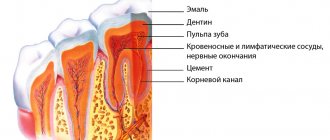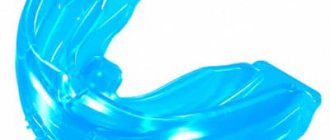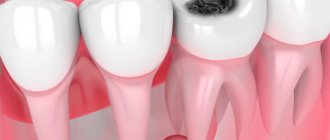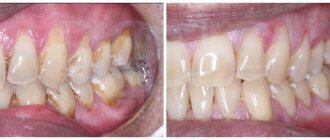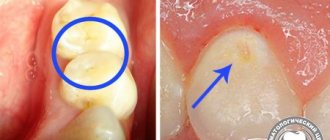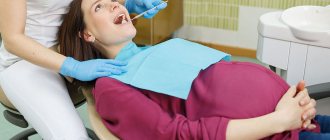Pulpitis is an inflammation of the internal structure of the tooth - the neurovascular bundle. In the vast majority of cases, this disease is caused by caries - many parents believe that it is not necessary to treat it, because baby teeth must be replaced quickly. However, this statement is incorrect, since caries, which is not addressed in time, causes tooth destruction and inflammation of the pulp.
Primary molars, especially the lower ones, are more susceptible to this. This is due to the relatively thinner enamel - the infectious process reaches the internal structures of the tooth faster. For the same reason, pulpitis in children develops much faster than in adults.
Among the causes of the disease are also injuries, including those associated with improper treatment of enamel caries, when the doctor accidentally exposes the pulp during tooth preparation.
What are caries and pulpitis?
Caries is a disease in which the hard tissues of the tooth are destroyed due to the loss of minerals from the tooth enamel.
How and why caries forms, read our article on the treatment of caries. The carious process, progressing, gradually reaches the pulp chamber, in which there is a neurovascular bundle of fibers that nourishes the tooth - the pulp, and destroys it. Bacteria from the carious cavity penetrate inside, infect the pulp, it becomes inflamed and pulpitis begins.
Both adults and children suffer from caries and pulpitis, but the course of the disease at different ages and its treatment differ.
Read about the treatment of caries and pulpitis in adults and pulpitis in baby teeth in the sections dedicated to these topics. In this article we will tell you about the treatment of caries and, especially, pulpitis of permanent teeth in adolescents, as well as about its features.
Method of surgical treatment of traumatic pulpitis
The surgical approach to the treatment of traumatic pulpitis comes to the rescue where it is no longer possible to cope with conservative intervention methods. It is used in critical and difficult circumstances, when a large area of the pulp is exposed and the infection can become permanent. The surgical approach is carried out in two successive stages:
First stage:
- The tooth surface is subjected to antiseptic treatment and an anesthetic is injected;
- Infected areas of the pulp are completely or selectively removed;
- The surgical site is dried and then an antibacterial pad is applied;
- The patient is given a filling temporarily until the next visit;
Second stage:
- The dentist removes the temporary filling and the area is once again treated with an antiseptic liquid;
- A lining with dental paste is applied and a permanent filling is installed.
Why do children under 14 years of age have an increased risk of caries and pulpitis?
During the period of formation of a permanent dentition, when the child’s permanent teeth begin to erupt, there are 2 factors that increase the likelihood of developing dental diseases and parents need to take them into account.
- The anatomical features of “freshly erupted” permanent teeth contribute to the development of caries and its complications. The incompletely formed, delicate enamel of young permanent teeth, especially in the area of numerous fissures (grooves) on the chewing teeth, is very vulnerable.
- A psychological feature of the “difficult” transitional age, when it is not easy to persuade a child to brush his teeth correctly and thoroughly, and, even more so, to go to the doctor and cure caries in a timely manner, especially if the child is afraid of the dentist.
Cost of treatment of traumatic pulpitis in Moscow clinics
In Moscow and the region, prices for the treatment of traumatic pulpitis vary greatly, depending on various factors and specific circumstances.
On average, mechanical, medical treatment and filling of one canal costs around 5,000 rubles.
Thus, we can conclude that treatment of pulpitis in Moscow clinics is a very expensive procedure, but often simply necessary. Take care of your dental health - caution and preventive care are cheaper than follow-up visits to the doctor.
Make an appointment with a therapist by phone+7(985)532-21-01
Tooth root caries treated or removed
Treatment of average dental caries from 6,000 rubles - sign up at the clinic of the Central Administrative District of Moscow
Caries in the white spot stage
Removal of a wisdom tooth cyst
Treatment of caries between the front teeth
Do fissure dental caries need to be treated?
Tetracycline teeth treatment, whitening, veneers
Features of diagnosis and treatment of caries of permanent teeth in adolescents.
To maintain the health of your teeth for a long time, you need to start carefully monitoring their health as soon as they erupt.
To do this, just follow a few simple rules.
- Provide quality hygiene, including professional dental hygiene for the child.
- Try to regularly attend preventive dental examinations at your clinic every 6 months, because... The development of caries in children in mixed dentition occurs very quickly.
- As a preventive measure at this age, it is recommended to do fissure sealing - this is “sealing” the recesses on the chewing surfaces of the lateral teeth
special filling material containing fluoride. This procedure mechanically closes the “weak” spots of the tooth and, at the same time, strengthens its enamel, releasing fluoride into the tissue.
- Teenagers often develop whitish spots on their teeth. It is necessary to find out what type of lesion such a defect belongs to - carious or not. This can be done by undergoing caries diagnostics with the Diagnocam apparatus in our clinic - this type of examination is digital and does not expose the child to radiation, therefore it is suitable for regular use. If a carious lesion is detected at an early stage, it can be cured without resorting to preparation using the modern ICON infiltration method
- If a child has crooked teeth and crowded teeth prevent them from being properly cleaned, then it is necessary to consult a pediatric orthodontist and begin orthodontic treatment.
- Treat caries in a timely manner in the early stages of the disease - this will allow you to save permanent teeth as much as possible from preparation, because the earlier caries is detected, the less affected tooth tissue the dentist will have to remove.
This approach to the child’s dental health, if not eliminates it, will significantly reduce the risk of serious carious lesions. If time was lost at the first symptoms of the disease, then a complication of caries – pulpitis – will have to be treated.
Prevention
Pulpitis can only be prevented by careful hygiene and timely treatment of any dental damage, from cracks, chips and caries to periodontitis. Basic preventive measures:
- Maintain good oral hygiene - in addition to brushing your teeth at home twice a day, use an irrigator and have your teeth professionally cleaned at a dental clinic.
- Eat right - a lack of calcium, phosphorus, vitamins C, D, group B in the diet, as well as microelements such as fluoride, leads to weakening of enamel and loosening of dentin, opening the way for the penetration of carious infection.
- Drink more water - a lack of this “universal solvent” in our body can cause a disruption in the acid-base balance, increased acidity of saliva and destruction of the enamel layer.
- Monitor the general condition of the body - monitor the course of chronic diseases. Control your hormonal levels and psycho-emotional state - most of the biochemical processes inside your body depend on them.
- Visit your dentist twice a year for preventive examinations.
All these efforts will help not only avoid tooth decay, but also contribute to the overall improvement of your health. Remember, a damaged tooth cannot be restored, and a new one cannot be grown in place of the lost one.
How is the progression of pulpitis in permanent teeth different in children?
Pulpitis is a serious disease, it must be treated, otherwise you can actually lose a tooth, get gumboil and even blood poisoning.
As in other age groups, pulpitis in adolescents under 14 years of age occurs in 2 main forms:
- Acute, with severe pain at night and in the evening, a painful reaction to temperature and chemical stimuli, an increase in temperature in case of general intoxication and the development of purulent complications.
In the absence of timely adequate treatment, the acute form becomes chronic.
- Chronic. This form of pulpitis can pass painlessly with the appearance of periodic pain reactions to cold, hot, sour, sweet. The acute inflammatory process in the pulp subsides, and the sluggish course of the disease contributes to the development of complications from periodontal tissues. Exacerbations occur periodically.
Attention parents! During adolescence, children may hide the disease and take painkillers uncontrollably.
Symptoms of acute pulpitis
As the disease develops, aching pain in the tooth first appears, which has an increasing character. The pain syndrome is constant or intermittent, significantly intensifies at night and with temperature influences. A diseased tooth reacts most strongly to cold. If you knock on the surface, the patient does not have any unpleasant sensations or they are insignificant.
The manifestations of symptoms of acute pulpitis depend on its form.
Hyperemia
It develops as a result of the activity of pathogenic bacteria that enter the dental tissue during untreated caries. It can occur during tooth preparation or after it has been treated with chemicals.
With hyperemia, the patient is concerned about the following symptoms:
- It's a dull pain. Occurs as a reaction to stimuli. Mostly, the painful attack does not last long, about 2 – 3 minutes, and at night lingering pain develops. In the case of an advanced form, the pain is felt as sharp and strong lumbago.
- Severe pain reaction when enamel is exposed to cold.
Acute focal
Signs that indicate the development of this form of pulpitis:
- Painful attacks occur spontaneously.
- They last for at least 30 minutes; in advanced stages they can last up to two hours.
- A carious cavity is revealed, which is painful during examination.
In acute focal pulpitis, the pain does not radiate to adjacent teeth.
Acute diffuse
It develops as a consequence of an advanced focal form and the lack of timely treatment.
Characterized by the following symptoms:
- The pain syndrome occurs spontaneously and suddenly, without exposure to any irritants. The pain is prolonged, does not go away for many hours, and radiates to nearby teeth.
- The presence of a carious cavity, when examined, a sharp painful reaction occurs. Remnants of filling material may remain.
Acute purulent
If the acute diffuse form is not treated, it gradually turns into a purulent form. Characteristic symptoms:
- The pain attack is cutting, acute in nature. The pain is constant and may periodically weaken or intensify.
- The pain radiates to neighboring teeth, as well as along the branches of the trigeminal nerve.
- When exposed to heat, the pain becomes stronger; when applying a cold compress, it subsides a little.
- Pus accumulates in the tooth cavity and can be detected by microscopic examination.
- The soft tissues melt and abscesses with pus form in them.
- The blood vessels are dilated and have many microdamages.
Traumatic acute
Develops as a result of tooth injury due to improper preparation of a carious cavity, chipping of a dental crown or fracture.
This form of pulpitis is characterized by the following symptoms:
- The pulp horn bleeds, which is noticeable during a dental examination.
- The dental cavity communicates pointwise with the carious cavity.
- In the pulp tissues, a bundle of vessels and nerves is exposed.
If there are signs indicating acute pulpitis of the tooth, treatment should not be delayed. A timely visit to the clinic will help save the tooth.
Features of the structure of newly erupted permanent teeth in children.
As we have already said, newly erupted permanent teeth in a child have a number of anatomical features and differ from the teeth of an adult, namely:
- They have fragile, not fully formed and mineralized enamel.
- They have unformed roots that connect to the growth zone.
- The root canals of such teeth are wide, with a funnel-shaped expansion towards the root apex.
- The thin and fragile walls of the dental canals do not have secondary dentin; they are easily injured and destroyed.
- There is insufficient mineralization of dentin in the roots of the tooth.
Therefore, when treating pulpitis of permanent teeth in children, there are a number of limitations and features that the pediatric dentist knows and must follow. Endodontic treatment (root canal treatment) of permanent teeth in children is complex and requires great care.
By the way, for this reason, it is better for adolescent patients to contact a pediatric specialist rather than an adult dentist-therapist.
Where to contact?
If you notice symptoms of pulpitis, you can contact the dentists of the Good Hands clinic. They have extensive experience in treating this disease and have everything necessary to make it successful. We use effective anesthesia, modern drugs and gentle techniques that allow treatment without pain. You can schedule a free consultation with us and find out all the necessary information right now by filling out an application on our website or calling us by phone.
Methods for treating pulpitis in adolescents under 14 years of age, and how do they differ from treatment for adults?
Before starting treatment, the dentist’s main task is to determine whether the patient’s permanent tooth has roots, what stage of formation they are in, and also to find out the condition of the tooth, the location of the source of inflammation, the shape and length of the root canals. To do this, the patient must undergo an x-ray.
Treatment will be different for teeth with formed and unformed canals.
There are 3 main methods of treating pulpitis.
- A conservative method of treating pulpitis is without removing the pulp; during the treatment, the canal is washed with an antiseptic, a calcium-containing paste is applied to the pulp chamber and filled.
- Partial pulp removal
This method involves removing the infected coronal part of the pulp, cleaning and rinsing the cavity, which is then filled with a drug. After the inflammation subsides, the tooth is filled.
- Surgical method with complete removal of the pulp (depulpation). In this case, the pulp is removed, the canals are expanded and washed, and then filled.
We do not use arsenic pastes to treat pulpitis - the same popularly known “arsenic” to “kill” the pulp. Modern technologies and materials make it possible to treat pulpitis using more humane methods for patients of all ages.
Read more about these techniques in our articles:
Treatment of pulpitis of baby teeth
Treatment of pulpitis (in adults)
When and what methods of treating pulpitis of a permanent tooth in a child can be used?
- A child’s diseased permanent tooth has unformed roots.
In this case, during treatment ONLY gentle methods of treating pulpitis are used - a conservative method of treatment or partial removal of the pulp while preserving its living root part.
Depulping – i.e. Complete removal of the pulp is not applicable for such teeth, because their pulp connects to the tissues of the growth zone, which will be injured, and this is not allowed. It is necessary to preserve the living growth zone until the formation of the tooth and periodontal tissues is completed.
In the process of treating permanent teeth with developing roots, all manipulations are aimed at relieving inflammation and preserving the growth zone of the tooth. Subsequently, to avoid relapses, it is recommended to regularly monitor the patient using radiography until the tooth root is completely formed, and then carry out high-quality endodontic canal treatment.
- A child’s diseased permanent tooth has already formed roots.
When treating such a tooth, any of the above methods can be used, including complete removal of the pulp (depulpation). The latter is preferable, but the dentist chooses a technique based on the specific situation.
- Conservative treatment is carried out in case of “early” stage of the disease and in case of injuries.
- Partial pulp removal is effective in treating chronic and onset acute forms of pulpitis.
- The indication for depulpation is any form of pulpitis with severe pain and if other methods do not produce results.
How to prepare a child for treatment?
Treatment of pulpitis of primary teeth in children is a rather complex task, so it’s great if the child is already familiar with the dentist’s chair. The first visit should be preventative - to familiarize yourself with the office environment, the doctor, and the instruments.
Also, the task of parents is to psychologically prepare the child. Required:
- talk to your child about doctors in a positive way - tell them that the dentist treats teeth and makes sure they don’t hurt;
- play dentist with toys and other family members;
- avoid mentioning pain or unclear, scary terms;
- do not deceive the child - explain that dental treatment may not be very pleasant, but it will not last long and the tooth will no longer hurt;
- remain calm, act gently but confidently if the child resists treatment;
- choose a suitable time for visiting - it is better in the morning, when the baby is alert and active;
- take a toy with you to calm the child;
- give the doctor the opportunity to establish contact with the small patient - do not rush him;
- Do not scare the child under any circumstances, do not threaten, do not blackmail.
If the situation cannot be controlled completely, you will have to reschedule the appointment for another day. However, the disease should not be ignored - treatment of pulpitis of baby teeth in children must be carried out one way or another. In special cases, treatment under general anesthesia may be considered, but this should be discussed with your doctor.
Other important features of the treatment of pulpitis in permanent teeth for children under 14 years of age:
In order for the treatment of pulpitis to be successful and the patient to have no relapses or complications, it is necessary to:
- Strictly maintain sterility to avoid infection during treatment.
- Use a rubber dam to isolate the patient’s oral cavity from the manipulation field.
- Carry out a thorough filling of the canals - the voids left in them will provoke the re-development of inflammation.
- Monitor the quality of canal filling after treatment using repeated x-ray diagnostics.
- Do not forget that not only adults, but also children need high-quality fillings and dental restoration, and, sometimes, even prosthetics with ceramic inlays.
Clinical researches
“Results of clinical use of the Asepta series of products: already at the first control examination (after 1-2 days) of using the Asepta line of products, there is a decrease in complaints of discomfort, but bleeding persists when brushing teeth. On the 7th day, complaints of gum bleeding persisted in 4 patients. Upon examination, a decrease in hyperemia and swelling of the gums was noted, but bleeding persisted upon probing. After the final application of the gel with propolis, normalization of clinical manifestations was revealed, which is manifested by the absence of bleeding during brushing and probing.”
Sources:
- The effectiveness of the use of Asept “adhesive balm” and Asept “gel with propolis” in the treatment of chronic generalized periodontitis and gingivitis in the acute stage (Municipal Dental Clinic No. 4, Bryansk, Kaminskaya T. M. Head of the therapeutic department Kaminskaya Tatyana Mikhailovna MUZ City Dental Clinic No. 4, Bryansk
- Study of the clinical effectiveness of treatment and prophylactic agents of the Asepta line in the treatment of inflammatory periodontal diseases (A.I. Grudyanov, I.Yu. Aleksandrovskaya, V.Yu. Korzunina) A.I. GRUDYANOV, Doctor of Medical Sciences, Prof., Head of Department I.Yu. ALEXANDROVSKAYA, Ph.D. V.Yu. KORZUNINA, asp. Department of Periodontology, Central Research Institute of Dentistry and Maxillofacial Surgery, Rosmedtekhnologii, Moscow
- The role of anti-inflammatory rinse in the treatment of periodontal diseases (L.Yu. Orekhova, A.A. Leontyev, S.B. Ulitovsky) L.Yu. OREKHOVA, Doctor of Medical Sciences, Prof., Head of Department; A.A. LEONTIEV, dentist; S.B. ULITOVSKY, Doctor of Medical Sciences, Prof. Department of Therapeutic Dentistry of St. Petersburg State Medical University named after. acad. I. P. Pavlova
- Report on the determination/confirmation of the preventive properties of personal oral hygiene products “ASEPTA PLUS” Remineralization doctor-researcher A.A. Leontyev, head Department of Preventive Dentistry, Doctor of Medical Sciences, Professor S.B. Ulitovsky First St. Petersburg State Medical University named after. acad. I.P. Pavlova, Department of Preventive Dentistry
- Clinical studies of antisensitive toothpaste “Asepta Sensitive” (A.A. Leontyev, O.V. Kalinina, S.B. Ulitovsky) A.A. LEONTIEV, dentist O.V. KALININA, dentist S.B. ULITOVSKY, Doctor of Medical Sciences, Prof. Department of Therapeutic Dentistry, St. Petersburg State Medical University named after. acad. I.P. Pavlova
How is pain relief performed when treating pulpitis in adolescents under 14 years of age?
Pulpitis is often accompanied by severe pain, so high-quality and safe pain relief is especially important for effective treatment and comfortable well-being of the patient.
Treatment of pulpitis in children is carried out completely without pain, for this purpose local conduction anesthesia is used. For severe pain, it is combined with intrapulpal anesthesia.
To prevent a child from having a negative reaction to an injection of an anesthetic drug, in our clinic we use local application gel anesthesia (freezing).
If there is increased anxiety, preliminary sedation is recommended; before visiting the dentist, the child can be given light sedatives - valerian, Novopassit, motherwort tincture, according to the instructions and in the dosage indicated for his age/weight.
Diagnostics
Diagnosis of this type of pulpitis is not difficult, since most often there is either a chipped crown or a trace of the treatment. The dentist conducts an examination, collects anamnesis and analyzes the patient’s pain symptoms, and also directs him to undergo an X-ray examination.
Is it possible not to treat pulpitis if the teeth are baby?
There is a common opinion that it is not necessary to treat baby teeth, because they will soon fall out. This is the biggest mistake parents make. Untreated pulpitis leads to irreparable consequences and even affects permanent teeth:
- purulent abscess, periodontitis, life-threatening condition;
- deep infection affecting the germ of a permanent tooth;
- malocclusion due to early tooth extraction due to untimely treatment;
- pain interferes with normal chewing of food, uneven load on the teeth leads to accelerated destruction of other elements.

